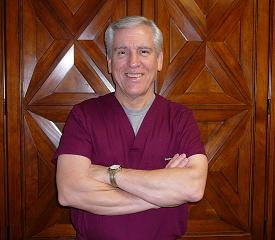Recently I saw a patient who went through knee replacement. His major problem was significant peripheral edema from below the knee all way to the foot. For more than two weeks I battled with it. I did the entire LDM protocol but edema was coming back the next day with the same intensity. Both the patient and I were discouraged.
After thinking and analyzing his symptoms, I decided to concentrate on the posterior knee before LDM application. I relaxed the posterior leg muscle, did connective tissue work, worked on the tendinous parts of the gastrocnemius and soleus muscles and at their insertions. I repeated the same protocol for the hamstring muscles. After all of that I applied LDM protocol on the affected lower extemity. These adjustments in the treatment protocols made a huge difference. Within a week I got the peripheral edema on the leg and foot under control.
When my patient went to see both his primary care physician and his surgeon they both were amazed at the difference in his leg. The edema for all intents and purposes was gone. His primary care physician, who regularly refers patients to me, told the patient that I was his only hope but that even he was amazed at the results.
On the other hand, the surgeon’s reaction was completely different. He didn’t know and asked the patient what he had done to completely eliminate the edema. The patient replied that it was the efforts of his massage therapist that fixed the edema problem. The surgeon told him that a massage therapist could not have brought about this kind of a change in such a short period of time, if ever. Despite that, the patient went on to describe how much he had to urinate during and after my visits and the surgeon still didn’t believe him.
Bu Curt Lezanic, LMT, San Antonio, Texas
LESSONS:
1. If lymphatic drainage is compromised as a result of scar tissue formation, especially after surgery (knee replacement in this case), LDM by itself doesn’t guarantee stable clinical results of edema elimination. It will help to reduce edema, but it will have a tendency to come back.
2. Correct adjustments in the treatment strategy resulted in decreased tension in the soft tissues around packs of popliteal lymph nodes and local stretching of the scar tissue formed around them. By doing that Curt was able to mobilize popliteal lymph nodes and prepare them for the following application of the LDM, which increased hydrostatic pressure in the soft tissues, emptied lymph nodes and restored proper lymph drainage from the areas below the surgery.

Curt Lezanic received both a Bachelor of Science and a Master of Science degrees in education from Kearney State College, now known as the University of Nebraska at Kearney. His teaching experience includes junior high and senior high teaching in public education and faculty positions in higher education. Administratively, he has worked as a department head, dean and campus director primarily at the community college level.
In the early 1990’s, Curt returned to the classroom as a student to pursue massage therapy. He worked for several years at a local resort/spa as a contract massage therapist and developed a local clientele. In 2009, Curt was approached by Dr. Scott Campbell. Dr. Campbell asked Curt to work with several of his patients who were experiencing various muscular/skeletal issues. Over the next several months, what had begun as a part time on call relationship with Dr. Campbell grew into what was becoming a full time commitment. In 2010, Curt retired from the college where he had worked for twenty two years and established his massage practice at the office of Dr. Scott Campbell in San Antonio, Texas.
Science Of Massage Institute
Category: Blog , News
